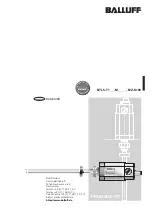
5V
Signal
Generator
Scope
Ch1
Ch2
JMP4
1
2
3
4
VCC
1
2
3
JMP14
D - input
of
SN65HVD95
Powering up the EVM and Taking Measurements
www.ti.com
Figure 4. Example for Stimulus and Probe Points with JMP4 and JMP14
gives an example for entering a data signal into the driver section of the Sympol™ transceiver.
The signal output of the generator is adjusted to 5V. The generator’s ground terminal is connected with pin
3, and the signal output terminal with pin 2 of JMP4. The data signal is measured via an oscilloscope with
its signal input connected to pin 1 and its ground wire connected to pin 2 and of JMP14.
The same set-up applies to the DE and RE inputs via their corresponding headers JMP2 and 12 and
JMP3 and 13. JMP1 however, must not receive a signal stimulus. Like JMP11, it represents the receiver
output, R, of the SN65HVD96.
Instead of using signal generators, the EVM can directly interface to micro controller I/O. Then the
non-assembled 50
Ω
resistors are of no concern. However, for proper operation, it must be assured that
the high-level input voltage V
IH
≥
2 V and the low-level input voltage V
IL
≤
0.8 V.
3
Powering up the EVM and Taking Measurements
The generally recommended procedure for taking measurements is listed:
1. Install the ground connections required.
2. Connect the oscilloscope with the respective probe points you want to measure.
3. Adjust the power-supply to 5 V.
4. Adjust the generator outputs for a 5 V maximum output signal level, or check the logic switching levels
of the controller I/O.
5. Connect the power supply conductor with pin 3 of TB1 and observe the blue LED (D1) turning on.
6. Connect signal conductors from the controller or the generator with their corresponding EVM inputs at
JMP2 to JMP4.
7. Logic high at the receiver output, R, will turn on the red LED (D3), and logic high at the driver input, D,
turns on the green LED (D2). If D is left open, an internal 100 k
Ω
pull-up resistor provides logic high
instead. However, due to the small input current, D2 will remain off.
3.1
Measurement Examples
Each of the following measurement examples shows the equivalent circuit diagram and the corresponding
EVM set-up. Only the measurement relevant headers and terminal blocks are shown, and not necessarily
at their exact location on the EVM.
1. Standard Transceiver Configuration
Normal transceiver operation requires both, the driver and the receiver sections being active.
Therefore, the receiver enable pin (RE) must be at logic low potential and the driver enable pin (DE) at
logic high.
Transmit data entering at the D-input terminal appear as the differential output voltage (V
OD
= V
A
– V
B
)
on the bus wires, A and B. Via the active receiver, it is possible to sense the data traffic in transmit
direction.
4
Sympol™ Transceiver
SLLU128A – June 2010 – Revised August 2010
Copyright © 2010, Texas Instruments Incorporated






























